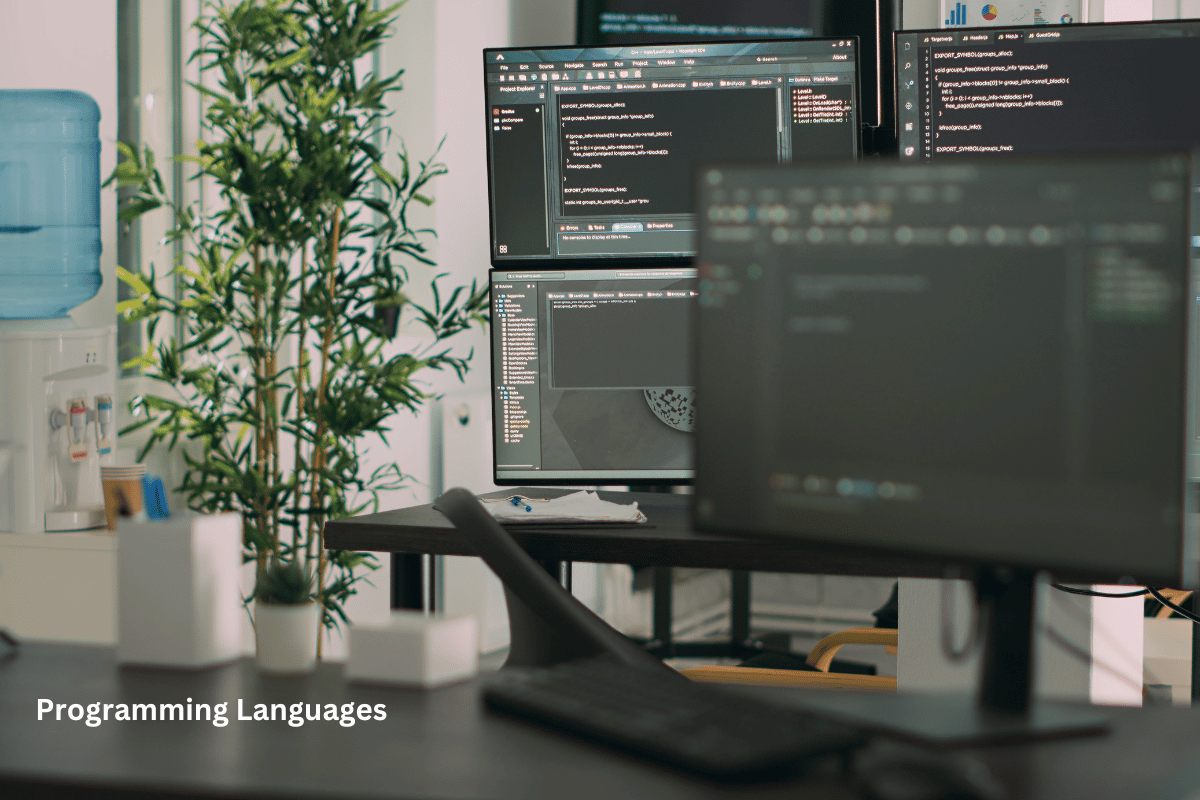Programming Languages: Tutorials on popular languages like Python and R for AI and data science.
Data science is key in today’s digital world, with tons of data being made every second. To make sense of this data and predict future trends, we need special programming languages. In fact, over 75% of data scientists use programming languages to do their work.
Python and R are top choices for data science. They’re loved for their flexibility, big libraries, and strong community support. This makes them perfect for AI and data science tasks.
Key Takeaways:
- Data science heavily relies on programming languages for analysis and model development.
- Python and R are the predominant languages used in AI and data science.
- Both languages offer powerful libraries and vibrant communities.
- Programming languages like SQL, Julia, JavaScript, Scala, Java, Go, MATLAB, C/C++, SAS, and Swift also have applications in data science.
- Mastering Python and R opens the door to a world of exciting possibilities in the field of data science.
Top Programming Languages for Data Science
In data science, programming languages are key for digging deep into large data sets. Whether you’re just starting or have years of experience, knowing the top languages used in data science is crucial. These languages help in making sense of complex data.
Python is a top pick in the data science world. It’s known for being easy to use, versatile, and having lots of libraries. Python helps with handling data, making visualizations, and creating machine learning models. It’s also behind frameworks like TensorFlow and PyTorch, making complex algorithms easier to use.
SQL is a must-know for data scientists. It lets you work with databases, which is key for data handling. With SQL, you can do complex queries, join data, filter it, and aggregate it. These skills are vital for getting insights from databases.
R is made for statistical analysis and data tweaking. It’s loved by statisticians and data scientists for its wide range of statistical tools. R’s simple syntax and big library make it easy to work with data, build models, and make charts.
Julia is a newer language that’s fast and flexible for data science tasks. It runs as fast as languages like C/C++ but is as easy to use as Python or R. Julia is becoming popular for its speed and efficiency in data analysis and visualization.
Other languages also play big roles in data science. JavaScript is used for web work and making data visual. Scala and Java are great for big data and distributed computing with tools like Apache Spark. Go is known for its speed and efficiency. MATLAB is a favorite in academia and engineering. C/C++ is for high-speed tasks. SAS is big in finance, and Swift is for iOS apps and machine learning on Apple devices.
“Data science is no longer just about analyzing data; it’s about effectively communicating insights and making data-driven decisions. Proficiency in these top programming languages empowers data scientists to turn raw data into actionable knowledge.” – Anonymous
Knowing these top languages for data science opens up many doors in data exploration, model building, and deployment. By using different languages’ strengths, data scientists can uncover deeper insights and create strong systems to solve real-world problems.
Python for Data Science
Python is a top choice for data scientists worldwide. It’s simple and packed with libraries for data analysis, visualization, and machine learning. This makes it key in the data science world.
Python is loved for its strong libraries. NumPy, Pandas, and Scikit-learn are some of the best ones.
NumPy makes doing complex math easy. It helps data scientists work with numbers smoothly. From handling arrays to advanced math, NumPy makes it all simpler.
Pandas helps clean, transform, and analyze big datasets. It has tools like data frames for easy data work. This library makes data prep and analysis straightforward.
Scikit-learn is great for machine learning tasks. It has many algorithms for tasks like classification and regression. Data scientists can quickly make and use machine learning models with it.
Python is easy to read and use, even for beginners. Its simple syntax makes it welcoming for new learners.
It also has a big, active community. This means lots of support, resources, and tutorials for data scientists. It’s great for both new and experienced users, promoting sharing and learning.
In summary, Python is vital for data scientists. It’s versatile, has great libraries, and a strong community. Python helps with data cleaning, visualization, and machine learning, making complex data tasks easier.
R for Data Science
R is a top choice for data science. It’s a powerful language that helps with statistical analysis and data visualization. It has many libraries and packages that make it easy for data scientists to find important insights and make great visualizations.
dplyr is a key library in R. It makes working with data easy by letting users filter, arrange, and summarize it efficiently. This helps data scientists do complex tasks without a lot of trouble.
ggplot2 is another big name in R. It’s all about making data look good through graphs and charts. With it, scientists can share their discoveries in a way that’s easy to understand.
The caret package is also important. It means Classification And REgression Training. It has lots of tools for training and checking machine learning models. This makes it easier for scientists to build predictive models and pick the best features.
R is all about stats too. It has a lot of functions for testing hypotheses and doing regression analysis. This helps scientists analyze data deeply and make solid conclusions.
R Markdown and Shiny make data science even better. R Markdown lets scientists mix code, visuals, and text in one document. This makes sharing research easy. Shiny helps create interactive web apps, so scientists can share their work in a fun way.
R is a favorite among data scientists for many reasons. It has great libraries, stats tools, and easy-to-use frameworks. Whether you’re into complex stats, making visuals, or predictive models, R is a key tool. It helps scientists find insights and make smart choices.
Conclusion
Choosing the right programming language is key for success in data science and AI. With more demand for data-driven solutions, knowing the best languages is crucial.
Python is a top choice for data scientists and AI experts. It’s easy to learn and has many libraries. This makes it great for beginners. Plus, the Python community offers lots of support and collaboration.
R is excellent for statistical analysis and data visualization. It has many packages for these areas. This makes it a strong tool for researchers and statisticians.
Java and Scala are great for big data and scalable applications. They offer high performance and strong frameworks for data processing.
Julia is a new language in data science and AI. It’s fast and simple, making it promising for complex computations.
There’s no single best language for data science and AI. It’s important to try different languages and adapt to your project’s needs. By exploring various options, you can find the best one for your data-driven projects.







